The #CIO: UBS Group CIO Oliver Bussmann
How the Swiss giant's information chief derives value in 140 characters or less
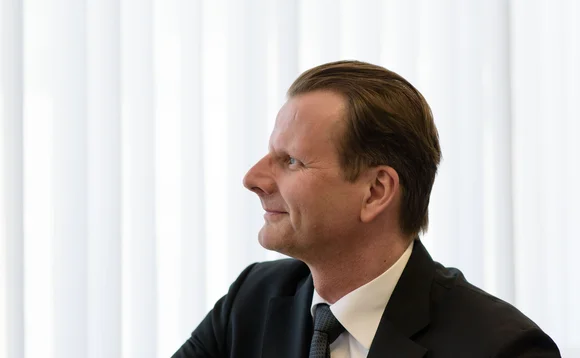
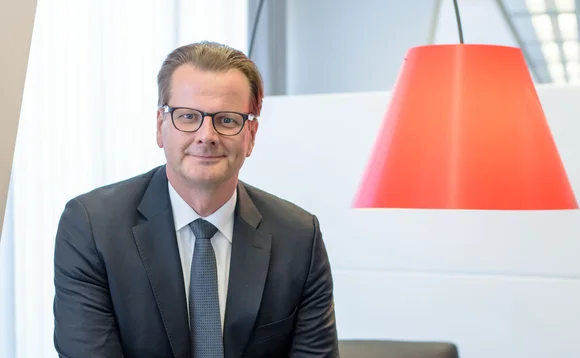
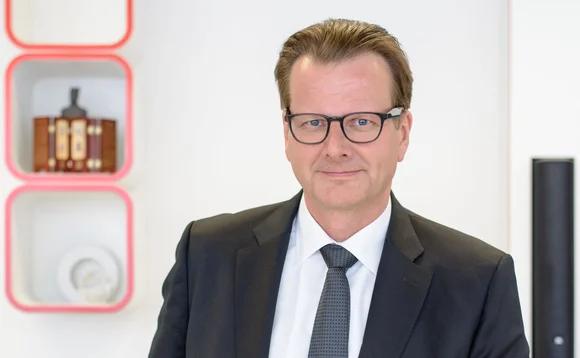

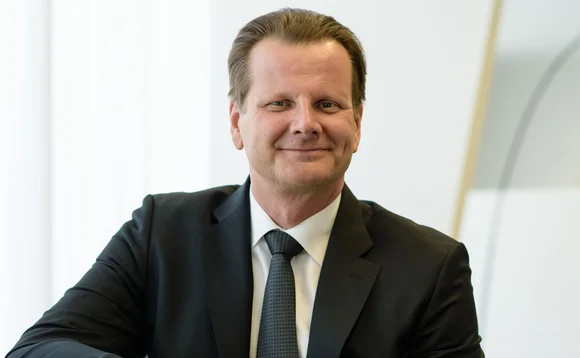
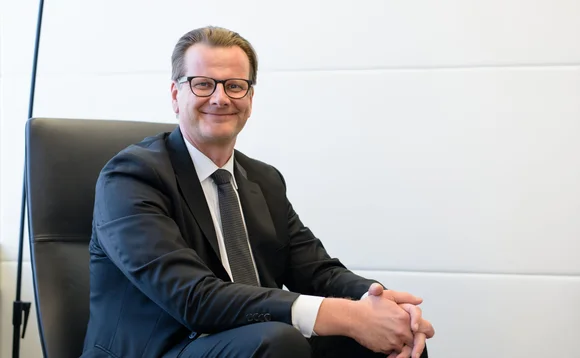
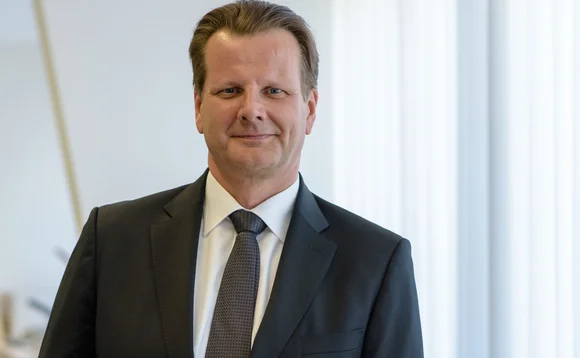
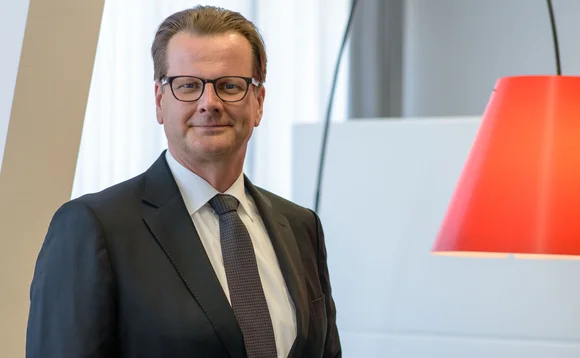
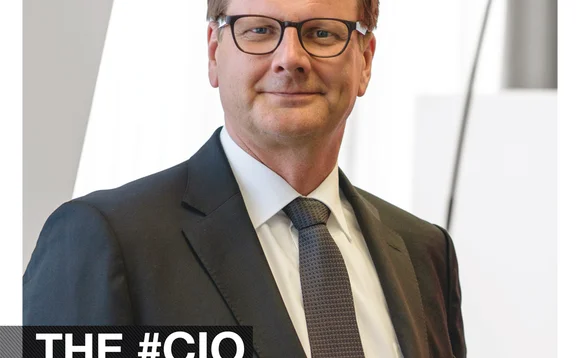
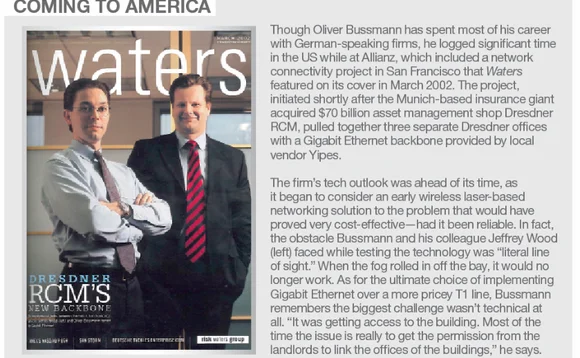
A few years ago, a network infrastructure executive named Vala Afshar set about a fun project for the Huffington Post: creating a list of 100 must-read tweeting business executives, the first of its kind.
He managed to do so quite successfully, though with one obvious oversight. Somehow, and somewhat counterintuitively, not a single member of the list was a CIO. Ever assiduous and never one to miss a detail, Oliver Bussmann, then in the senior leadership at SAP in Germany, got in touch with him—fittingly enough, via Twitter. After a bit of research, Afshar developed a separate list of social media-savvy CIOs in early 2013. And Bussmann, wouldn’t you know it, came top.
Given its propensity to get major corporations—to say nothing of everyone else—in trouble, a bank technology team without some sense of social media is, in 2015, hopelessly behind.
But whereas Twitter and other platforms might seem a fleeting gimmick or even the reverse—an existential threat—to some fintech executives, they are neither of these things to Bussmann, who implores his 60,000 user clients across 56 countries to start actively tweeting. In fact, the CIO believes new communication mediums are nothing less than crucial elements in the investment bank’s larger operation, with possibilities great enough and challenges of security scary enough that underlying tools and infrastructure are, themselves, transformed along the way.
Indeed, it’s an active posture implying a great deal of technology change—something the Swiss bank has lately proven quite open to. And in Bussmann, they have a CIO with a long history of running directly toward the fray, with Apple iPhone in hand, and jumping in.
“This principle can drive how you communicate internally: identifying the key people who will spread a message within a network, and combining that influence with technology. My style as a CIO has really changed because of this way of thinking.” Oliver Bussmann, UBS
Matters of Orchestration
One measure of technology’s incipient progress is that Bussmann, accompanying his former colleague Jeffrey Wood, has actually graced the cover of Waters before—way back in 2002, for an article about securing fiber optic Gigabit Ethernet for Dresdner RCM’s offices in San Francisco, shortly after Allianz purchased the asset manager. Phones weren’t “smart” then, and Twitter was four years away from launch. Fast forward to today: Dresdner no longer exists at all, and Gigabit Ethernet seems comparatively Paleolithic.
In some important ways though, Bussmann’s work at Allianz, as well as his earlier run managing IT for Deutche Bank’s private banking arm and his more high-profile role as CIO at SAP, all influence how he shapes UBS’ financial technology at the functional, business strategy, and above all, innovation levels.
“In 2002, we were focused on driving efficiency on the business side, because, unbelievably, there was a shortage of resources in the Bay Area,” he says, recalling the Dresdner project. “Moving to SAP was really where I added on the disruptive innovation piece. Depending on the state of the IT organization you spend more time on functional piece first, but the innovation side will always eventually increase, and in some cases, orchestrating disruption comes at the very beginning. At UBS, I get a sense of focusing on several of these dimensions at once.”
They blur today, in no small part because of Bussmann’s unusual dedication to social media. Not exactly an early Twitter adopter, Bussmann joined in early 2010 while at SAP, and things took off from there.
He fondly remembers the moment just a couple of months later that made SAP’s head of production engineering jump out of his chair. Along with its early work with mobile apps and tablet technology, SAP would begin treating Twitter, still primarily considered a consumer medium, like an enterprise-level platform. The ensuing social media chatter—which would make Bussmann a household name among C-level twitterati—was about Twitter, itself. The medium, as Jean Baudrillard once put it, was the message.
“Soon after we started describing our plan, I had a lot of people tweeting me with questions, including press asking to interview me. This was the point when I realized enterprise mobility could be a serious thing, that leveraging these social channels can be very powerful in driving focus and attention on topics with the potential to bring major transformational change,” he says.
Valuable Impressions
Bussmann’s vision for information sharing at UBS is ambitious, and today extends well beyond traditional matters of mobility. From an external-facing product perspective, UBS put enterprise mobility at the center of its new flagship Neo platform, and especially targeted foreign exchange (FX) and commodities insights and tools to be developed with universal availability in mind.
But this posture is also a pragmatic, catalytic mechanism for change, which explains why the bank hired Bussmann from SAP in 2013. Working with Swiss authorities, which helped bail out UBS immediately following the financial crisis, the bank has been one of the most public among its tier-one brethren in shedding businesses and reshaping its operational, risk management, and technology functions. UBS has become profitable along the way by becoming leaner. And it has managed that process by being more communicative—looking for value in every last Twitter impression (or instance a tweet was viewed) and other social media interactions much more closely.
“This principle can drive how you communicate internally: identifying the key people who will spread a message within a network, and combining that influence with technology. My style as a CIO has really changed because of this way of thinking,” Bussmann says.
Since his arrival, the bank has focused heavily on its use of Jive, a monitoring suite that tracks all of UBS’ internal social media across several systems. “Our activity has spiked,” Bussmann explains, and for the technology team specifically, he cites three reasons why.
“We’ve really pulled this into broader organizational transformation,” he explains. “Firstly, the whole social media topic helps me to make change management part of the equation, as we become a service-oriented technology organization, which manages the service level end-to-end with a ‘delivery factory’ that takes care of requirements and relationships.
“The second topic is on the development side, and has to do with taking our five different businesses and standardizing what we do with software development and resource management, to ensure optimal use of software assets,” he continues. “And third, we’re using this to drive the innovation ideation process: creating co-innovation spaces within the business to understand what kinds of trends are out there that we should focus on, work with private equity on, working in those ecosystems and exploring ideas before providing funding for execution in the investment portfolio. Examining that against our business model and strategy is also part of the transformation. All three of those pieces are critically important to ensure the success of this change.”
Early Measures
What does success look like? Many of us might measure our presence on social media by sheer number of connections—most financial journalists would envy Bussmann’s 11,500 Twitter followers—but the CIO’s evaluation of how UBS is doing is more sophisticated. For him, measuring the success of these processes has more to do with knowledge and outcomes than the number of strands comprising the web.
“At the beginning of any transformation you measure a lot, with a baseline to define changes against, gauging and publicizing progress so that the entire organization is aware of what the future state should look like,” he says. “From an innovation perspective, it’s about how many ideas were generated and how many are executed as part of our investment portfolio,” he says. “It’s looking at software lifecycles from beginning to iterative state and how we’re managing that. It is also location footprint and the number of vendors we use, driving at consistency there, while with infrastructure, it’s about the number of standards that are adopted and utilization of those standards.”
Bussmann is also quick to point out that marginal gains are easy to come by, while strategic change—just as it was in 2002—requires more patience and effort.
“You can achieve a lot of efficiencies in the short term, working on the labor pool or vendor portfolio,” Bussmann says. “But that’s not good enough. The next level is harder: simplifying your environment, standardizing the infrastructure and application library, understanding complexities and also looking at investment cases that are appealing to go after those complexities. Defining what’s necessary to break those down, getting the business behind that, and delivering on it is still the biggest challenge a CIO faces.”
Max Protection
Bussmann says developing thoughtful technology to comply with regulation, particularly more prescriptive requirements in some Asian jurisdictions, remains one of those complexities. Meanwhile, the trickiest among the rising puzzles all universal banks face—cyber crime—demands a collective response.
“The security topic is top of the agenda; it has to be,” Bussmann says. “Not only are the regulators concerned, but the number of malware and other attacks we’ve now seen has significantly increased, and using your community as your source for intelligence is vital. You can invest a lot to ring-fence your environment, and add more firewalls and other tools to ensure that you’re protected to the maximum. But with threats coming out like those against JPMorgan and Morgan Stanley late last year, it’s important that we as an industry recognize that working together with law enforcement, regulators, and peers gives us access to information and patterns, to determine how attacks happen, and to adjust capability.”
It’s also very human-resource intensive. “A taskforce or Swat team is there to guard your environment, protect it and try to minimize the impact, but the community must be able to help with those scanning capabilities too, identifying holes that you want to fill immediately. This combination of technological protection, the ability to leverage the community, and use of the Swat team is a different model to the past. Likewise, we’re very keyed in on third-party providers. Many banks are testing their vendors’ environments more thoroughly now, and in 2015 that’s a huge focus for us.”
Blockchain Next
Of course, even if hackers were to become benevolent overnight and UBS rationalized every last process with Swiss efficiency, Bussmann would have his sights on the next big, better thing. “My goal as CIO is to get at what’s available in the early stages and products that can really transform how we operate,” he says.
One of them is the digital ledger technology created as the basis for virtual currencies like Bitcoin, called Blockchain. It’s still bouncing around Bussmann’s head, thanks—no surprise—to social media, and he doesn’t parse words about its potential.
“Sharing my own thoughts on Blockchain and the ensuing conversation behind that really convinced me that we need to spend more time on this,” he says. “I genuinely think it will massively disrupt the buy and sell sides, payment streams and settlement alike, to the point where you can see that these things behave in totally new ways in five years.”
He points to the T+2 environment today, the years-long effort involved to reform it, and the delay that means for two days, firms can’t do anything with assets tied up in a transaction. A Blockchain ledger can change that, for good.
“With Blockchain, it’s all about simplifying the point of reference: In all different asset classes, anything that is a contract, a trader can reference digitally,” he says. “The key challenge is to make it available securely and to build more trust—to separate Blockchain from the news we’re regularly hearing about Bitcoin exchanges shutting down, like Bitstamp did in January. As an industry we need to build something to protect these assets. But if that happens, I believe the whole system will change. Internet-based exchanges based on these ledgers that will make assets tradable immediately, and the amount of effort to execute these things will be a fraction of what it was, so we’ll really move into a real-time environment going forward. You need a critical mass of parties in the end, so it will take time, but the advantages are real and very competitive. Not this year, maybe, but in the next few years.”
No Black Box
Some might call that naïve; others may wonder what a Blockchain is to begin with. But besides the democratizing forces of technology that he’s ridden throughout his career, Bussmann has another thing on his side of the argument: the tenfold increase in venture fintech investment from 2013 to 2014, now at more than $3 billion, which is projected to more than double yet again. With that kind of money on the line, it’s best to have someone who lives and breathes disruption at the helm, thinking ahead—and these days, often in 140 characters or less.
“As CIO you must make yourself accessible without barriers: to reach out, to comment, to ask questions,” Bussmann says. “It’s not a top-down process—it’s about finding entry points in your organization for ideas. For me, when significant interest is there to drive change in financial services like never before, the most important thing is to avoid being a black box.”
Oliver Bussmann Fundamental Data
Name: Oliver Bussmann
Title: Group CIO
Born: Ibbenbueren, North Rhine-Westphalia, Germany
Education: MBA: University of Münster, Germany
Number of Staff: About 20,000
Hobbies: Swimming and cycling
Twitter Handle: @obussmann
Who are your favorite Twitterers and why? I presented at the CxOTalk event in May 2014 and two of the key executives in the organization, Michael Krigsman @mkrigsman and Vala Afshar @valaafshar, are very well connected within the CIO community, and are at the forefront of driving the CIO topic across social media. I’ve followed them both on Twitter for many years.
On managing successful fintech investment: The key is to have a centralized team managing co-innovation spaces across the businesses and following a defined, best-of-breed process to bring potential projects from ideation through to design and development. Separately, another team should focus on managing the external elements of an ecosystem such as interactions with venture capitalists and start-ups.
For more on Blockchain: Bussmann suggests the uninitiated look at The Economics of Digital Currencies in the Bank of England’s third quarter 2014 quarterly report.
Only users who have a paid subscription or are part of a corporate subscription are able to print or copy content.
To access these options, along with all other subscription benefits, please contact info@waterstechnology.com or view our subscription options here: https://subscriptions.waterstechnology.com/subscribe
You are currently unable to print this content. Please contact info@waterstechnology.com to find out more.
You are currently unable to copy this content. Please contact info@waterstechnology.com to find out more.
Copyright Infopro Digital Limited. All rights reserved.
As outlined in our terms and conditions, https://www.infopro-digital.com/terms-and-conditions/subscriptions/ (point 2.4), printing is limited to a single copy.
If you would like to purchase additional rights please email info@waterstechnology.com
Copyright Infopro Digital Limited. All rights reserved.
You may share this content using our article tools. As outlined in our terms and conditions, https://www.infopro-digital.com/terms-and-conditions/subscriptions/ (clause 2.4), an Authorised User may only make one copy of the materials for their own personal use. You must also comply with the restrictions in clause 2.5.
If you would like to purchase additional rights please email info@waterstechnology.com
More on Emerging Technologies
The next phase of AI in capital markets: from generative to agentic
A look at some of the more interesting projects involving advanced forms of AI from the past year.
Market data costs defy cyclicality
Trading firms continue to grapple with escalating market data costs. Can innovative solutions and strategic approaches bring relief?
As trading firms embrace AI, so do hackers
According to a Google cybersecurity report, cybercriminals are turning to AI to sharpen their attacks.
AI & data enablement: A looming reality or pipe dream?
Waters Wrap: The promise of AI and agents is massive, and real-world success stories are trickling out. But Anthony notes that firms still need to be hyper-focused on getting the data foundation correct before adding layers.
Waters Wavelength Ep. 343: Broadridge’s Jason Birmingham
This week, Jason Birmingham of Broadridge talks with Tony about the importance of fundamentals as technology rapidly evolves.
Data standardization is the ‘trust accelerator’ for broader AI adoption
In this guest column, data product managers at Fitch Solutions explain AI’s impact on credit and investment risk management.
BNY inks AI deal with Google, Broadridge moves proxy voting to AWS, Expero delivers ICE market data, and more
The Waters Cooler: TSX Venture Exchange data hits the blockchain, SmartTrade acquires Kace, and garage doors link to cloud costs in this week’s news roundup.
Everyone wants to tokenize the assets. What about the data?
The IMD Wrap: With exchanges moving market data on-chain, Wei-Shen believes there’s a need to standardize licensing agreements.







